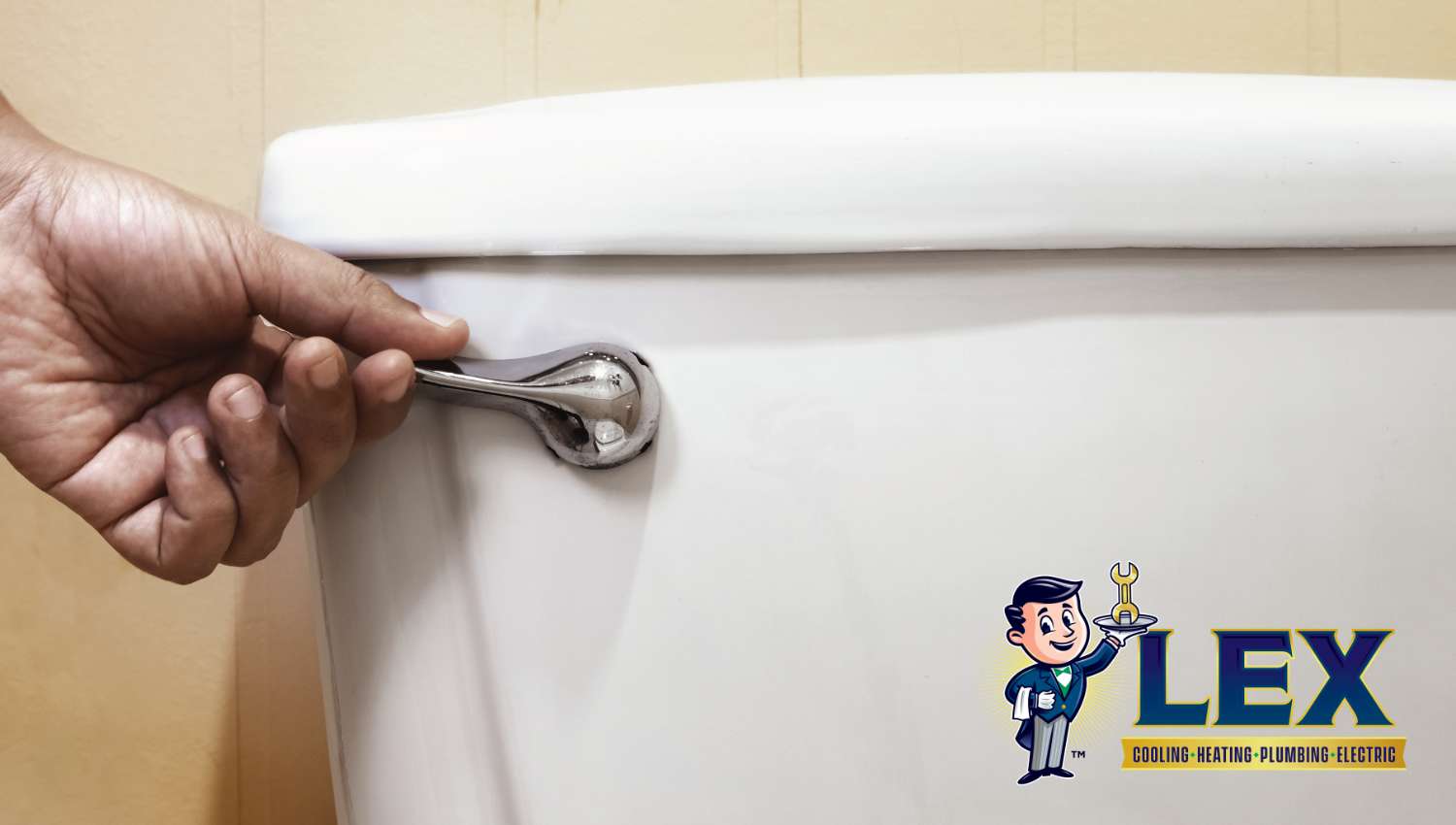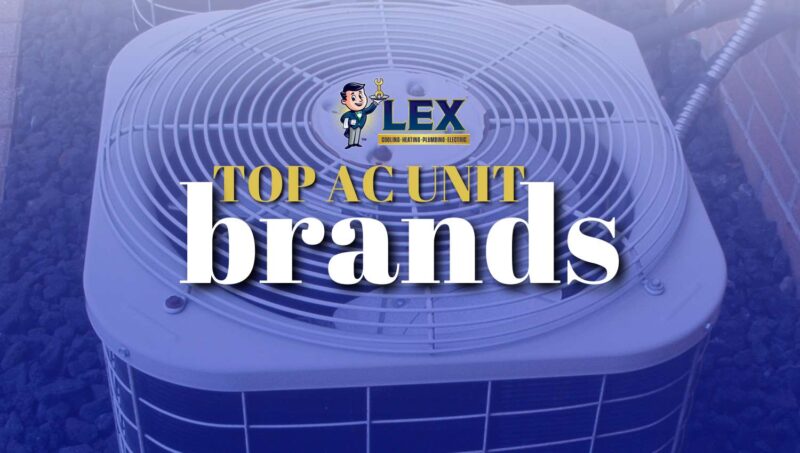When enjoying a quiet evening at home, an unexpected disruption like a loud toilet flush can be more than a nuisance. If your toilet flushes are louder than usual, there are several things that could be causing this disturbance. From malfunctioning components to plumbing system inefficiencies, understanding why your toilet is making such noise is crucial for restoring the harmony of your living space.
In this guide, our Carrollton plumbing experts at Lex explore the potential causes behind loud toilet flushes, offering insights tailored to the unique climate and plumbing concerns of Carrollton, TX and the surrounding DFW communities.
If you’re tired of listening to loud noises from your toilet, call Lex Air at (972) 217-8955 to schedule your plumbing service appointment today.
Why Is My Toilet Making Noise?
If you’ve ever been startled by strange noises coming from your toilet, you’re not alone. A noisy toilet can be annoying, disruptive, and sometimes even concerning.
However, before rushing to call a plumber, it’s helpful to understand the various reasons behind these sounds. From mysterious gurgling to sudden hissing, each noise holds a clue to potential issues within your plumbing system.
Normal vs. Loud Toilet Flushes
Different toilet flushes can vary in volume and sound, from a gentle whoosh to a thunderous roar. Understanding the distinction between a normal flush and a loud one can provide insight into the health of your plumbing system.
A typical flush should produce a consistent, moderate sound as water rushes through the pipes to clear the toilet bowl. However, if your toilet emits an unusually loud noise during flushing, it may indicate issues such as a malfunctioning fill valve, a blockage in the pipes, or excessive water pressure.
Why is My Toilet So Loud When Refilling?
When your toilet’s refill process generates an excessive racket, it indicates potential issues within the plumbing system. A normal, functioning toilet refill should be a relatively quiet process, with the tank quietly replenishing its water supply after each flush.
However, several factors may be at play if your toilet’s refill is unusually loud. From worn-out fill valves to high water pressure or even debris within the tank, understanding the root cause of this disturbance is essential to restoring quiet to your bathroom and ensuring the efficient operation of your plumbing system.
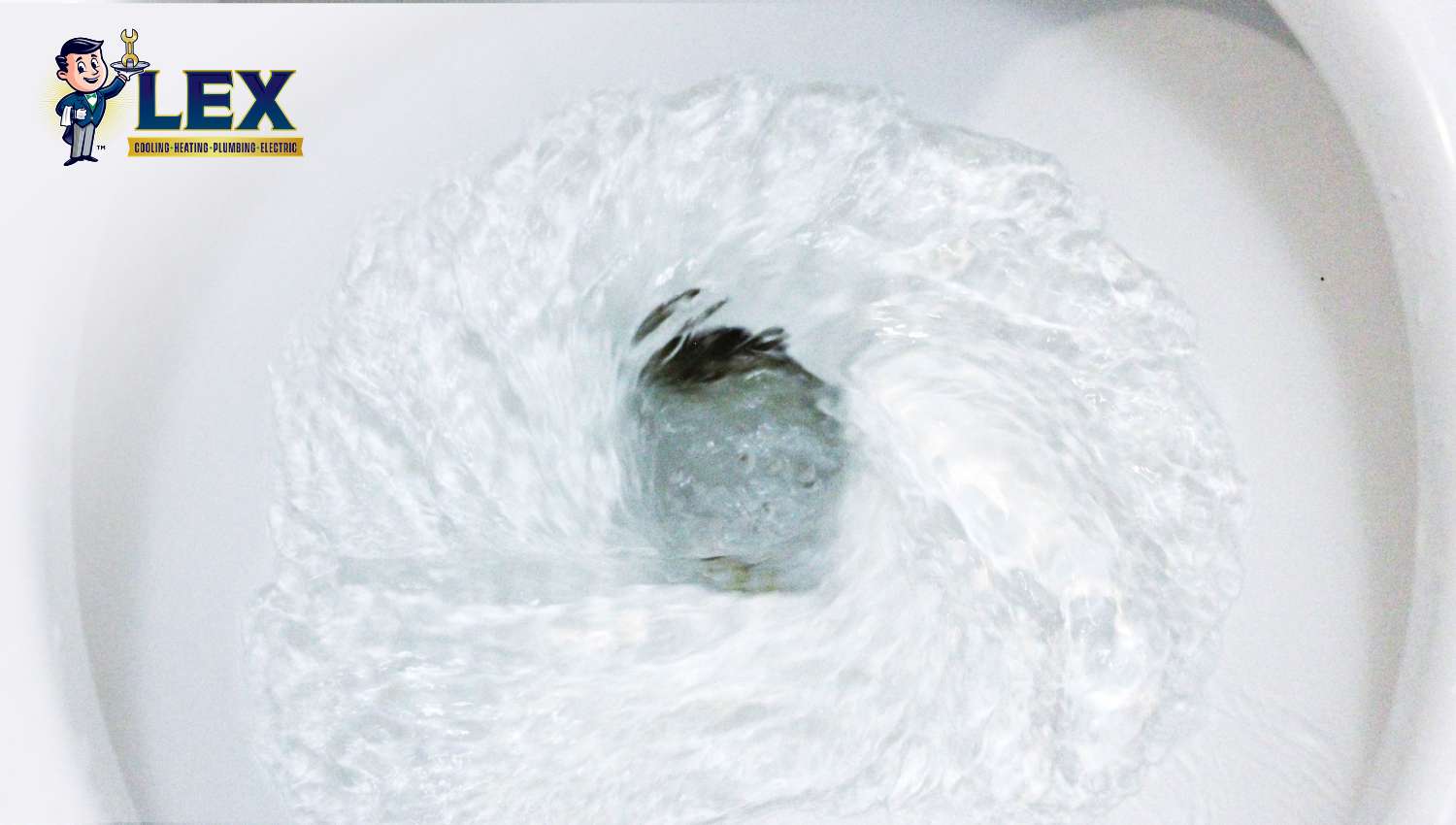
Possible Reasons for Loud Noises When Flushing the Toilet
When your toilet makes noises during its flushing cycle, something within your plumbing system requires attention. From a hissing sound to a hammering sound, these disruptive noises can mean it’s time to schedule a Carrollton toilet repair appointment:
Water Flow Issues
When the flow of water is abruptly stopped, or when air gets trapped in the plumbing lines, a shock wave reverberates through the pipes, leading to a whistling sound. These noises can indicate various problems, such as high water pressure, loose pipes, or air pockets.
Faulty Fill Valve
The toilet fill valve controls the flow of water into the toilet tank after each flush, while the overflow pipe ensures that water doesn’t spill out onto the floor. When the toilet fill valve wears out, becomes clogged, or malfunctions, it fails to close correctly, allowing water to keep flowing into the tank and out through the overflow pipe, creating a continuous cycle of filling and draining.
Malfunctioning Flush Valve
The flush valve, which sits at the bottom of the toilet tank, releases water into the bowl during a flush and then seals the tank to allow it to refill. When this valve is not working correctly, it can cause the toilet to run continuously, leak between the tank and the bowl, or fail to flush with full force.
This malfunction can be due to wear and tear on the valve itself, the deterioration of the flapper or fill valve seal, or an improper alignment between the valve and the flapper.
Restricted Water Supply Valve
A restricted water supply valve can contribute to loud noises by limiting the flow of water into the tank. When the water supply valve is partially closed or obstructed, it reduces the amount of water available for flushing, leading to turbulent flow and disruptive sounds like gurgling or splashing. Restricted water supply valves can be caused by sediment buildup, debris accumulation, or valve misalignment.
The water supply valve controls the amount of water that enters a fixture from the main supply line. When partially closed or obstructed due to sediment buildup or corrosion, water pressure and flow can be reduced, leading to weak flushing in toilets or slow-filling tanks.
Loose or Worn Toilet Parts
Components such as the handle, flapper, fill valve, and mounting bolts can become loose or wear out over time due to regular use, mineral buildup, or corrosion. These issues might manifest as a toilet that runs constantly, leaks, or has difficulty flushing properly.
A loose handle may not activate the flush mechanism effectively, while a worn flapper or seal can allow water to leak from the tank into the bowl, resulting in wasted water and increased utility bills. Loose mounting bolts can cause the toilet to rock, potentially breaking the wax seal and leading to leaks around the base.
Water Hammer
A water hammer is a plumbing issue characterized by loud, banging noises in pipes following a sudden water shut-off. This occurs when the flow of water is abruptly stopped, causing a pressure surge or shock wave that travels through the plumbing system, resulting in a hammering sound.
Water hammers can be more than just a nuisance; they can also lead to damage over time, including leaks or pipe breaks. The rapid change in momentum can strain connections and fixtures, leading to potential failures.
Mineral Buildup in Pipes
Mineral buildup is a common issue in areas with hard water, where water contains high levels of minerals like calcium and magnesium. Over time, these minerals can deposit on the inner surfaces of plumbing pipes and fixtures, reducing water flow and pressure.
Ventilation Issues
Proper ventilation is crucial for maintaining the pressure balance within the plumbing system, allowing waste water and gases to flow smoothly to the sewer or septic system. When vents are blocked, improperly installed, or insufficient, it can result in slow drainage, water traps drying out, and the buildup of harmful sewer gases in the home. These gases not only emit unpleasant odors but can also pose health risks to occupants.
Improper Toilet Installation
When a toilet is not installed correctly, various components may not fit together or be misaligned, leading to water leaks or air gaps. These issues can result in disruptive sounds like gurgling, splashing, or rattling. Additionally, improper installation can cause the toilet to rock or shift, worsening noise problems and potentially damaging the surrounding plumbing infrastructure.
Foreign Objects or Debris in Toilet Tank
Items that accidentally fall into the tank or sediment buildup over time can obstruct the movement of mechanical parts, such as the flapper or the fill valve, leading to improper sealing or filling of the tank. This can result in continuous running water, inefficient flushing, or even the inability to flush.
Debris can also cause wear and tear on these components, requiring premature replacement. Additionally, foreign materials can disrupt the balance of water flow and pressure, leading to inconsistent flushes.
Aging Plumbing System
An aging system poses several challenges that can impact the functionality, safety, and efficiency of a property’s water distribution and waste removal. Over time, toilet pipes made from materials like galvanized steel or cast iron can corrode, reducing water flow and increasing the potential for leaks and water contamination with rust or harmful metals.
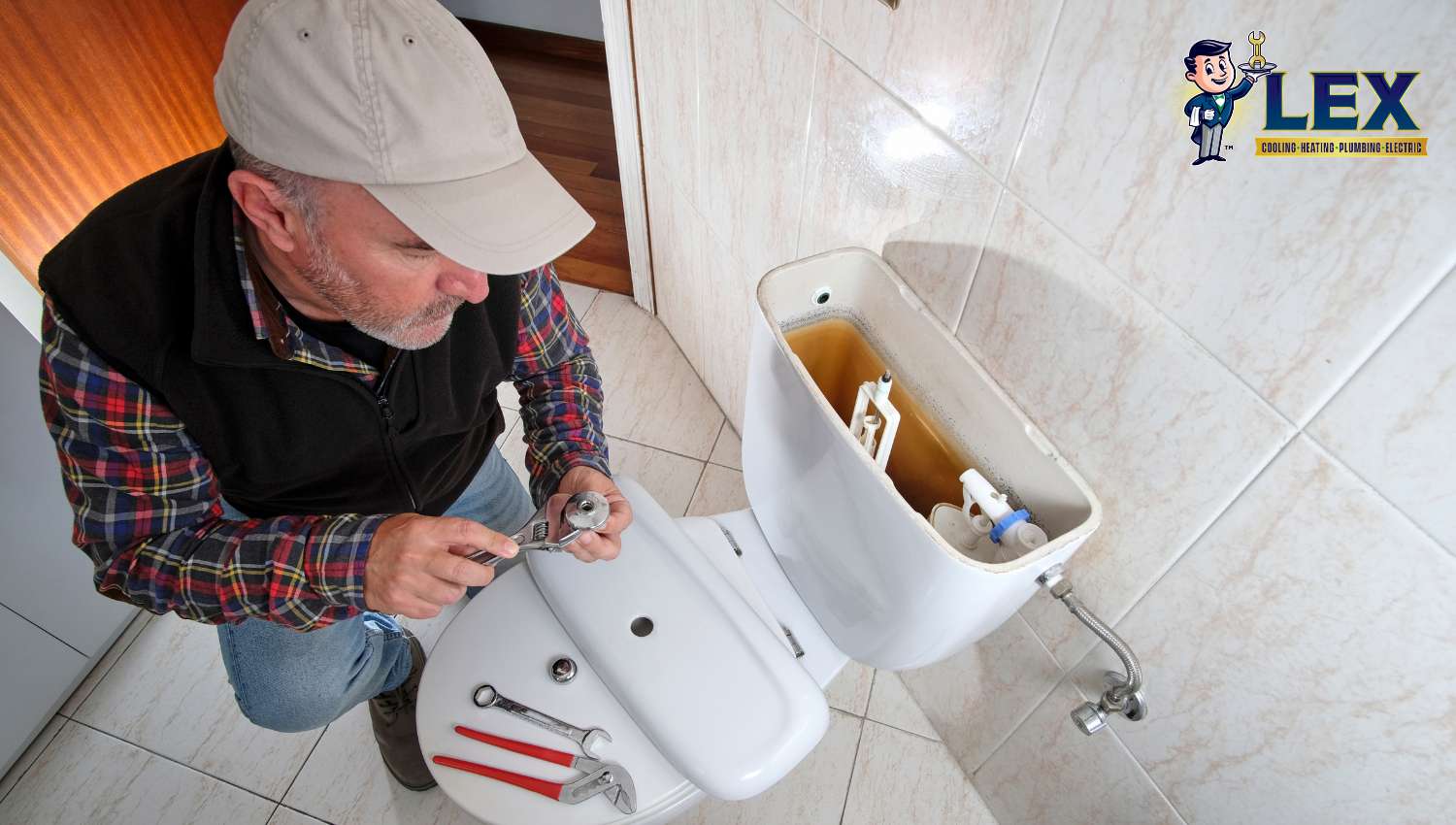
How To Stop Noisy Pipes When Flushing Toilet
To stop noisy pipes when flushing a toilet, several steps can be taken to address the underlying causes of the disturbance:
- Adjust the water pressure to a suitable level to minimize abrupt surges.
- Install water hammer arrestors to absorb shockwaves from sudden water flow changes.
- Secure loose pipes and tighten all plumbing connections to reduce vibrations and noise.
- Check for blockages or restrictions in the toilet fill valve or overflow tube.
- Consider installing pipe insulation to dampen sound and prevent noise transmission.
DIY Solutions vs. When To Call a Professional Plumber
When facing plumbing issues such as noisy pipes during toilet flushing, it’s important to understand the balance between DIY solutions vs. calling a professional plumber from Lex Air.
While DIY solutions can often resolve minor issues and save on costs, if the problem continues or you’re uncertain about the cause, it’s wise to enlist the expertise of a professional plumber. They possess the knowledge, experience, and specialized tools to diagnose complex plumbing issues and ensure proper repairs.
Certain situations, such as suspected leaks, damaged pipes, or issues within the main water supply line, require professional attention to prevent further damage.
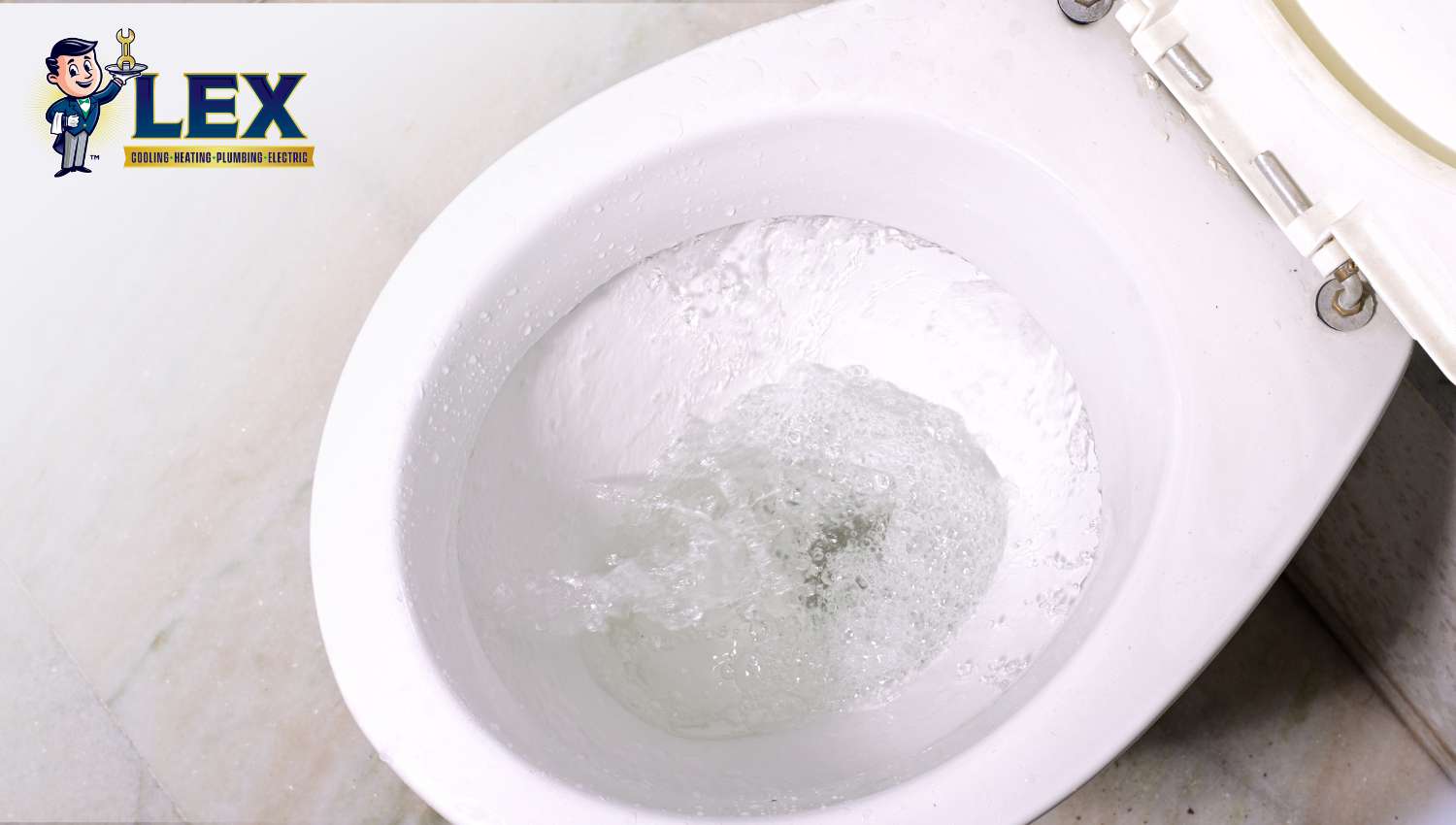
Plumbing Issues? Call the Experienced Carrollton Plumbers at Lex Today
From noisy pipes during toilet flushing to complex repairs and installations, trust the experienced Carrollton plumbers here at Lex. Our plumbing pros are dedicated to providing fast, reliable service and delivering lasting solutions to ensure the efficiency and integrity of your plumbing system.
Don’t let plumbing issues disrupt your peace – contact Lex today at (972) 217-8955 for professional assistance you can count on.

